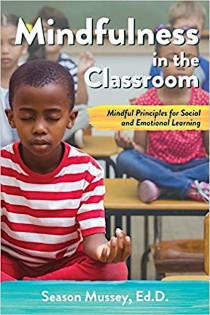Mindful Principles in the K-12 Classroom
Mindfulness in the Classroom: Mindful Principles for Social and Emotional Learning
By Season Mussey, Ed.D.
(Prufrock Press, 2019 – Learn more)

In her book, Mindfulness in the Classroom: Mindful Principles for Social and Emotional Learning, Season Mussey shows that she truly cares about students and educators and wants more teachers to see the “whole child.”
Mussey believes that social and emotional learning is needed before any true academic learning can occur. This book would appeal to a K-12 educator who is looking to incorporate more SEL strategies into daily interactions with students.

Mussey’s focus is on social and emotional learning, its need and importance, and how to best share its principles with students. She also includes a variety of SEL activities such as journaling and discussion topics geared toward educators. She believes that “when teachers develop social and emotional competency in themselves, it is possible for them to support this learning in students.”
From foundations to a call to action
The book is organized into three parts and also includes an appendix with sample lesson plans. In Part I, Mussey shares the foundations and basic framework for social and emotional learning. Part II is the heart of the book as she breaks down each of eight mindfulness principles that support SEL development and gives examples of how to incorporate them in daily practice.
Part III is Mussey’s call to action for the reader to incorporate the book’s ideas in ways that make a positive change in society. This review will focus on Part II of the book: the eight mindful principles.
Although Mussey gives theoretical reasons for the importance of each principle, she also shares practical ways to apply that principle in an SEL framework. Throughout each section there are “TRY THIS” sidebars that describe various activities that can be incorporated into classroom activities.
While some activities may take only a minute or two, others are slightly more involved. At the end of each chapter, a journal prompt for the reader also helps in allowing processing and deeper thinking about the concepts.
The eight mindful principles
Principle 1 focuses on “I” Work which reminds the reader to truly know herself and her values so that she can most effectively carry them on to her students.
Principle 2, Creativity, outlines the various ways that creativity helps nurture social and emotional learning. In an age where education is becoming more fact and data driven, this was a refreshing reminder of the power of creativity.
Cultivating Connections is the focus of Principle 3, in which Mussey writes about the importance of self-care and improving relationships with others, including students. Once again, she reminds the reader that teachers cannot be strong emotional role models for students if they do not take care of themselves. Mussey includes a self-care assessment as well as a self-care plan in this section. She addresses key concepts of gentleness, patience, compassion and empathy – all ideals that often need to be taught to children today in our world of increasing online connecting and decreasing intrapersonal connecting.
In Principle 4, Mussey describes the power of Writing in improving self-awareness and self- reflection and as a way of regulating emotions and managing stress. She includes a variety of writing prompts and suggests using writing as a way to informally communicate with students on a regular basis. This is something I do in my classroom at times and reading about it reminded me that it can be a great way to communicate and connect with students who may not be as verbal or outgoing.
Principle 5, Breathing and Movement, is one that I personally find one of the most vital aspects of teaching and learning. I regularly weave yoga and kinesthetic techniques into my lessons, and this section was a reminder of just how important that can be. Focused and controlled breathing helps the brain oxygenate itself so that it can function more effectively. Breathing can help students increase focus and energy and decrease anxiety and stress.
When discussing movement Mussey makes the point that students are going to move anyway, so she encourages teachers to teach kids how to move and include movement in a meaningful way. One tip that I found helpful was the concept MOVE FIRST. I often get into a habit of trying to push through material before I weave in a movement break, thinking that once students are moving, it might be harder for them to re-focus. Mussey states that though it might seem the opposite, movement actually helps students find more calm, focus and attention to task. This year, I plan to prioritize moving first!
Principle 6 focuses on Gratitude as a way to help students become more self-aware and socially aware. One of the TRY THIS activities I loved in this section was having students write thank you notes. I plan to offer this as an option for an early finisher activity in my class.
Holding Space, the concept of principle 7, is more abstract and hard to grasp. Mussey describes holding space as a way for an individual to be present and give another person what they need at that time. One writer has described it this way: When we hold space for other people, we open our hearts, offer unconditional support, and let go of judgement and control. (Source)
Finally, in Principle 8, Commit-To-One, Mussey encourages the reader to “Do just one thing” from the book and “Finish that thing.” She asserts that commitment increases self-confidence and by committing to just one thing, and doing it one step at a time, both students and teachers can achieve their goals. Her suggestion for teachers in this chapter – to write, or re-write – their teaching philosophy. For teachers who have been teaching for a while, I think this is a great way to reconnect with the reasons you became an educator.
This book would be an asset to anyone who wants to reach their students in different ways and understands that teaching is much more than just academics.
Shawn Lawn teaches sixth grade social studies in Hillsborough, New Jersey and has been teaching middle grades for 21 years. In addition to her degree in Education, she holds an MA in Counseling and various certifications in yoga and mindfulness, and has a strong interest in reaching students on an emotional and personal level. When she is not teaching or learning, Lawn can be found on the yoga mat or spending time with her husband and son, especially cheering on her son in baseball.




























